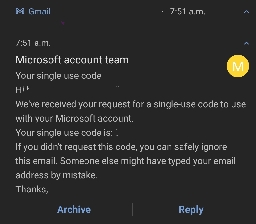I started to get these daily at random hours, even when I'm sleeping. Someone's trying to hack me?



I sure don't feel safe just ignoring it, considering the frequency.
You are viewing a single comment



I sure don't feel safe just ignoring it, considering the frequency.
It is actually safe to ignore them. It means either someone has an email address similar to yours, or a bot of some sort has you email address and only your email address.
Essentially, someone or something goes to the login screen, enters your login, and says "I don't have the password, let me in!".
Sending a code to your email like this is the first step in letting someone in without the password, or more specifically to having them reset it.
Since the email is to check "did you ask for this?", doing nothing tells them that you did not.
If you want some extra peace of mind: https://account.live.com/Activity should show you any recent login activity which you can use to confirm that no one has gotten in.
Also, use two factor, a password manager, and keep your recovery codes somewhere safe. The usual security person mantra. :)
This is all good information and seems well intentioned, but it's worth pointing out in a post about account security that clicking links provided by others and giving it your login information is very unwise (even/especially links in emails like these). For the link you provided, it'd be better to recommend going through a primary microsoft page or login that can be confirmed by the user and getting to the activity history page from there
That is wonderful advice and I'm glad you pointed that out. :)
If I knew how to give directions to the page, I would, but unfortunately I don't know the Microsoft site layout, only the URL that their help center directed to.
In mitigation of my indiscretion: it's generally safer to trust a person you approach out of nowhere than to trust someone who approaches you out of nowhere.
Since they chose the venue and asked the question, the likelihood that an attacker is present in the replies is lower than the expectation that an unsolicited email is from an attacker.
But it's also entirely correct to be distrustful of anything anyone asks you to click on, triply so if it involves security or login pages.
For MS guides there usually is an article under support.microsoft.com or learn.microsoft.com (usually more advanced, admin related documentation for company / enterprise level stuff) domains. Here's an article for checking activity.
Well, I found the recent activity and none of these were me. At least they all appear to say Unsuccessful sign-in.
Yup, that would indicate that likely a bot is trying to guess it's way in.
You are still safe.
The only weird thing here is that Microsoft lets such things bother you instead of guessing that you didn't teleport to Brazil and instead putting a little extra burden on the Brazil end before sending you an email.
If you're still feeling worried, the biggest thing you can do is enable two-factor auth (which you should do anyway), or even better: enable something like passkeys which are very secure and also easier than username/password.
Two-factor/password manager is the "remember to brush and floss" of the security industry, so... Please do those things. :)
Considering most of the attempts are from India and Brazil I suspect a service you signed up for has sold your email to unsavory data brokers and now a bunch of scam companies are doing that MFA attack on you
You can create an email alias for your Microsoft account and then only enable login from that account. If you then do not use that email for anything but the login, you should be pretty safe from credential stuffing attacks.
I had a very similar issue with multiple failed login attempts and changing my login email stopped it right away.